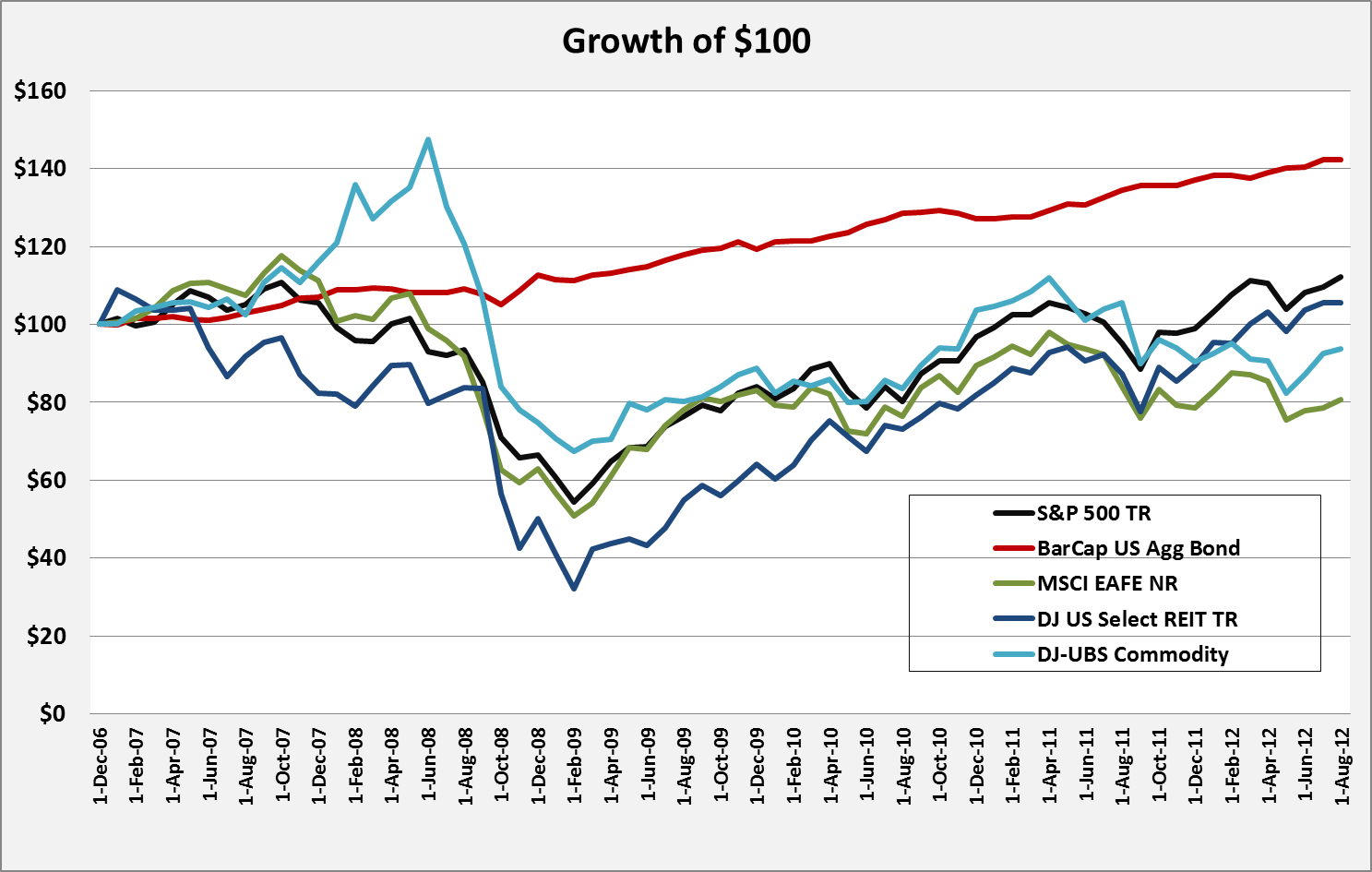By: Steve Sosnick, Chief Strategist at Interactive Brokers
As we start 2023 and I take a week off, it seems like an opportune time to look back at our best and worst calls of the second half of 2022. (Part 1 can be found here) On balance, I would say we got more correct than not, though I really wish we were more emphatic about some of them.
Before we look backwards, here is my basic outline of what to look for in 2023:
- Volatility is likely to continue as long as the world’s central banks continue to withdraw liquidity. That includes balance sheet reduction, which is likely to continue even after rate hikes cease.
- Although Fed Funds futures and the Treasury yield curves imply that rates will be lower in the near-term – as soon as the second half of next year — think about the message they send:
- A rapid return to a rate cutting regime implies that the economy cools sufficiently for the Fed to become worried more about a slowing economy than inflation.
- If inflation does revert to around 2%, that doesn’t mean that the Fed will reverse its policy. They can keep it relatively static if the economy remains healthy. Hence, a hoped-for soft landing does not imply a return to accommodation.
- That means that the base case for the bond market is an imminent recession. If you’re hoping for a quick reversal of Fed policy, be careful what you wish for.
- The idea that “good news is good news” and vice versa will take greater root as investors increasingly recognize the risk of recession and favor economic results that appear to reduce the likelihood one.
Now, onto last year’s second half highlights…
I Wish I Could Rearrange Earnings Season – July 12th – “If I had the power to reorganize earnings season, I would not have the major banks kick off the festivities.” “It is human nature to try to extrapolate trends from limited data sets, and an early slew of bank earnings offers an unrepresentative small sample of data from which market commentators (present company included) try to divine a trend for the flood of reports that will follow. No other industry’s bottom line is nearly as dependent upon idiosyncratic items like the shape of the yield curve and trading results.”
The Goldilocks VIX – July 14th – “One of the questions I’m asked most often is why is the CBOE Volatility Index (VIX) so high or so low. And yes, the question is posed in both directions about equally. I assert that volatility, using VIX as a proxy, is neither too hot nor too cold. It is just about right. The direction of the question is usually a “tell” for whether the inquirer is bullish or bearish about stocks.”
Been Down So Long It Looks Like Up to Me – July 15th – “… keep these two important factors in mind. First, don’t fight the Fed. Even if we seem ok with a 75 or 100 basis point rate hike, the Federal Reserve still has a restrictive stance. And remember that they have only begun to timidly implement their promised balance sheet reduction. They have been raising the cost of money, by raising rates, but not doing much to shrink the amount of money via quantitative tightening. Second, if we do get a solid rally, remember that bear market rallies are short, sharp and ferocious. If we rally because there appears to be meaningful positive shifts in the economy and central bank stances, then the move higher could indicate a lasting bottom. If we rally from oversold conditions simply because market psychology became too grim, then the rally is likely to be short-lived.”
Socially Acceptable Volatility Strikes Again – July 21st – “We tend to worry about market volatility when we decline by a significant amount but take a similar rise in relative stride. They’re supposed to go up, right? It is important to remember that volatility is a mathematical concept, measuring up and down moves alike. Yet when it comes to market psychology, we know that they are vastly different.”
Yay, We Might Be in a Recession! – July 28th – “If you ever doubted that stock traders are a liquidity addicted mob, desperately awaiting any news that might bring them sweet relief from the current phase of withdrawal, yesterday’s rally should put any contrary illusions to rest.” “The line “a man hears what he wants to hear and disregards the rest” seemed to perfectly describe traders’ reaction to the Powell presser.”
The Bond Market is Sending a Message That Stocks Ignore – August 5th – “…the bond market is telling stock traders, pretty much screaming in their faces, that the Fed will not be riding to the rescue anytime soon.”
US Investors Making a Big Parlay Bet – August 18th – “The recent rally in equities implies that we will thread a very tight needle – that we will be able to maintain solid earnings growth amidst moderating inflation that will occur with neither aggressive Fed action nor a recession.”
Can “Goldilocks in a Suit” Keep the Bears Away? – August 25th [the day before Jackson Hole] — Before this morning’s bounce I was ready to assert that a dour response was already priced into both the stock and bond markets. Now I am less certain about the former.”
Is the Put/Call Ratio Telling Us Anything Meaningful? – September 20th – “Many of us tend to look at the put/call ratio as a contrary indicator. The logic is that when people are flocking to puts, the risks that they are attempting to either hedge or profit from are largely behind us.” “The put/call ratio can be a very useful tool – one that I consult often. But its messages are far from foolproof, and its false messages can be costly. Use with care.”
Equity Investors, Get Over Yourselves (Fed Put Edition) – September 30th – “This week we saw the “BOE Put” activated when the Bank of England stepped in to buy UK Gilts.” “Put simply, the BOE stood by for months and even continued to raise rates as gilts, stocks and the pound all fell steadily. They only stepped in when the credit markets were severely threatened. And their actions stopped the bleeding.” “It’s another reminder that when central banks make their moves, it’s not usually about equities.”
Happy 35th Birthday, Fed Put – October 20th – “I assert that the “Fed Put” was born around noon on October 20th, 1987.” “Because I was not privy to the actual phone calls, I’ve never been able to say with 100% assurance that our buy program was backstopped by the Fed.” “I don’t doubt that the traders who ran Salomon were inclined to buy the largest dip ever, but it is hard to imagine that they would have committed a potentially staggering amount of capital without a backstop.” “But it is crucial to realize what drove the Fed to an unprecedented intervention. It wasn’t just that equities were collapsing, it was that the financial system was collapsing.”
Looking Back at Crypto’s Wild Ride – November 15th – “Would cryptos have become mainstream, let alone a mania, if we had positive real interest rates? I think not. Zero nominal and negative real rates encouraged all sorts of speculative excesses. This was just the most extreme.” “How could anyone credibly assert that Bitcoin or any other cryptos could be an inflation hedge when they literally never existed in a period when inflation was problematic? I find it a difficult, if not impossible argument.”
Understanding Put/Call Ratios – November 18th – “I prefer to do two things. First, I focus on the total options volume across all exchanges. There are too many vagaries that influence order routing; I prefer to remove them from the data. Second, I prefer to use moving averages to analyze the data. When daily readings are as disjointed as we see in the graph above, it is quite helpful to smooth them with a moving average.”
Market to Fed: “Are We There Yet?” Fed to Market: “Quiet Back There” – November 21st – “It occurred to me last week that Fed governors must feel like annoyed parents right now… Investors are ever hopeful for a pivot, a pause, or some other sign that the Federal Reserve will relent in their fight against inflation. In effect, they are like anxious children wondering – against all obvious evidence – whether the Fed has reached their destination. And like the frustrated parent behind the wheel, the commentary from a range of various Fed talking heads seems to reflect that frustration.”
Our Obsession with Second Derivatives – December 5th – “We have now come to recognize that inflation – the first derivative of prices – may be above the Federal Reserve’s 2% target for some time. Hoping for a quick reversion to stable prices is largely futile, so instead we are focusing more on whether inflation is slowing. In other words, in our hunt for “peak inflation” we are seemingly more concerned about the second derivative of prices – whether the rate of change in prices (inflation) is slowing.”
Can XLE Remain Relatively Unscathed as Oil Falls? – December 8th – “If investor preference and performance chasing provide the rationale for XLE’s gains, we can understand why institutional portfolio managers would want to hold onto a winning sector into year-end. Will that preference continue as the calendar turns? If oil can reverse its recent declines, then quite possibly yes. If oil continues its months-long malaise amidst economic concerns, it seems likely that XLE and the energy sector could succumb to the relentless rotation that continually occurs in equity markets.”
So, Good News Can Be Good News Again – December 21st – “Last week we wrote: ‘At some point … equity investors will need to decide which is more important to them – easy money or a decent economy. Odds are we’re not getting both.’ For today, at least, they have decided that a decent economy is more important. Let’s see if that persists into the start of the new year.
This post first appeared on January 4th, 2022 on the IBKR Traders’ Insight Blog
PHOTO CREDIT: https://www.shutterstock.com/g/Rudzhan
Via SHUTTERSTOCK
DISCLOSURE: INTERACTIVE BROKERS
The analysis in this material is provided for information only and is not and should not be construed as an offer to sell or the solicitation of an offer to buy any security. To the extent that this material discusses general market activity, industry or sector trends or other broad-based economic or political conditions, it should not be construed as research or investment advice. To the extent that it includes references to specific securities, commodities, currencies, or other instruments, those references do not constitute a recommendation by IBKR to buy, sell or hold such investments. This material does not and is not intended to take into account the particular financial conditions, investment objectives or requirements of individual customers. Before acting on this material, you should consider whether it is suitable for your particular circumstances and, as necessary, seek professional advice.
The views and opinions expressed herein are those of the author and do not necessarily reflect the views of Interactive Brokers LLC, its affiliates, or its employees.
Any trading symbols displayed are for illustrative purposes only and are not intended to portray recommendations.
In accordance with EU regulation: The statements in this document shall not be considered as an objective or independent explanation of the matters. Please note that this document (a) has not been prepared in accordance with legal requirements designed to promote the independence of investment research, and (b) is not subject to any prohibition on dealing ahead of the dissemination or publication of investment research.
DISCLOSURE: ALTERNATIVE INVESTMENTS
Alternative investments can be highly illiquid, are speculative and may not be suitable for all investors. Investing in Alternative investments is only intended for experienced and sophisticated investors who have a high risk tolerance. Investors should carefully review and consider potential risks before investing. Significant risks may include but are not limited to the loss of all or a portion of an investment due to leverage; lack of liquidity; volatility of returns; restrictions on transferring of interests in a fund; lower diversification; complex tax structures; reduced regulation and higher fees.
DISCLOSURE: ETFS
Any discussion or mention of an ETF is not to be construed as recommendation, promotion or solicitation. All investors should review and consider associated investment risks, charges and expenses of the investment company or fund prior to investing. Before acting on this material, you should consider whether it is suitable for your particular circumstances and, as necessary, seek professional advice.
DISCLOSURE: FOREX
There is a substantial risk of loss in foreign exchange trading. The settlement date of foreign exchange trades can vary due to time zone differences and bank holidays. When trading across foreign exchange markets, this may necessitate borrowing funds to settle foreign exchange trades. The interest rate on borrowed funds must be considered when computing the cost of trades across multiple markets.
DISCLOSURE: DIGITAL ASSETS
INTERACTIVE BROKERS LLC IS A MEMBER OF NFA AND IS SUBJECT TO NFA’S REGULATORY OVERSIGHT AND EXAMINATIONS. HOWEVER, YOU SHOULD BE AWARE THAT NFA DOES NOT HAVE REGULATORY OVERSIGHT AUTHORITY OVER UNDERLYING OR SPOT VIRTUAL CURRENCY PRODUCTS OR TRANSACTIONS OR VIRTUAL CURRENCY EXCHANGES, CUSTODIANS OR MARKETS.
Trading in digital assets, including cryptocurrencies, is especially risky and is only for individuals with a high risk tolerance and the financial ability to sustain losses. For more information about the risks surrounding the trading of Digital Assets please see the “Disclosure of Risks of Trading Digital Assets“.
DISCLOSURE: OPTIONS TRADING
Options involve risk and are not suitable for all investors. For more information read the Characteristics and Risks of Standardized Options, also known as the options disclosure document (ODD). To receive a copy of the ODD call 312-542-6901 or copy and paste this link into your browser:
http://www.optionsclearing.com/about/publications/character-risks.jsp
DISCLOSURE: FUTURES TRADING
Futures are not suitable for all investors. The amount you may lose may be greater than your initial investment. Before trading futures, please read the CFTC Risk Disclosure. A copy and additional information are available at ibkr.com.



